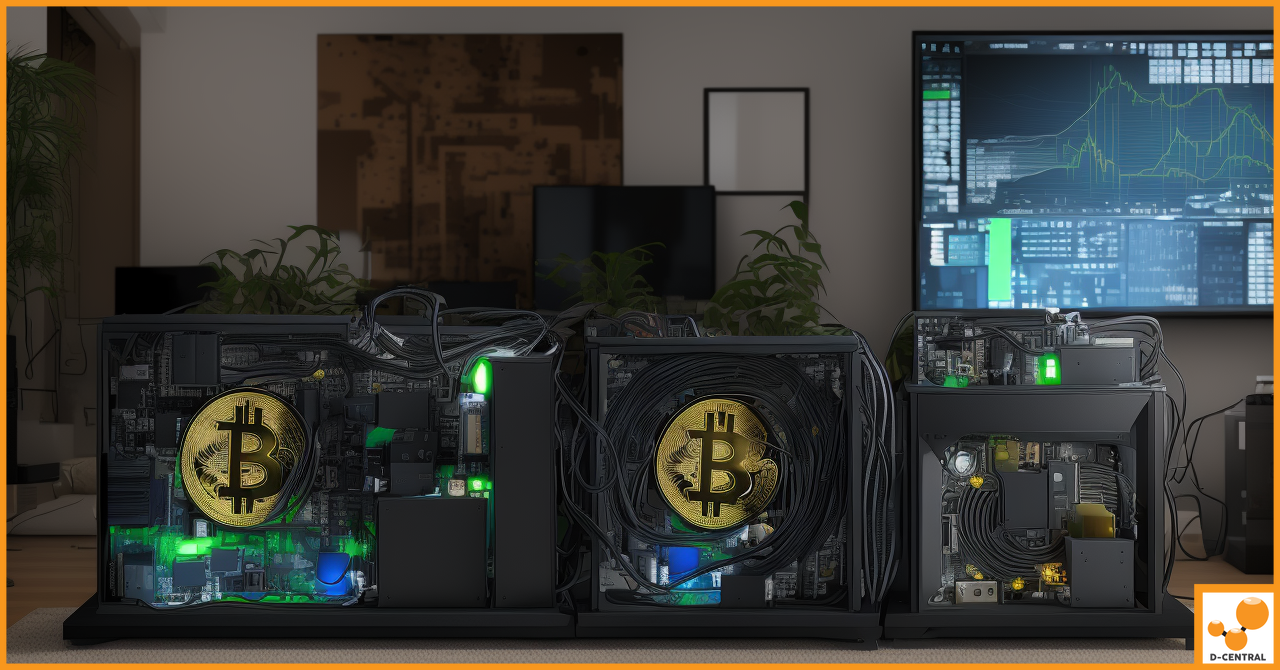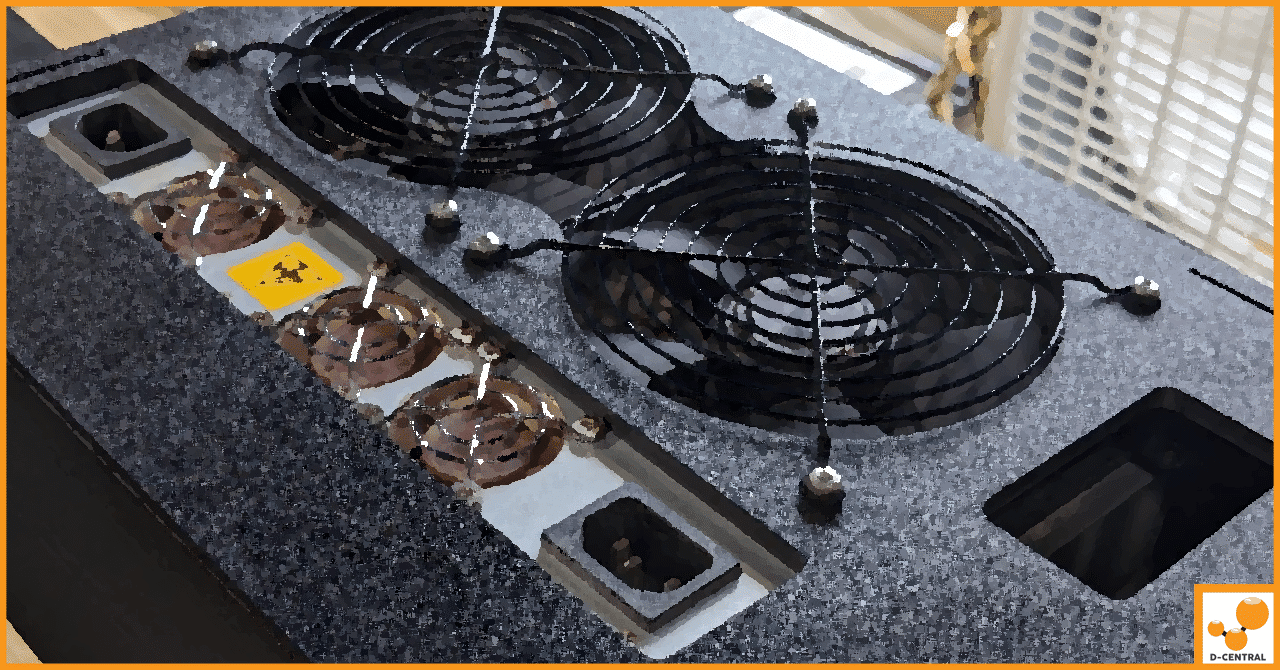
Revolutionizing Home Heating with Cryptocurrency Mining Space Heaters
Welcome to the future of home heating! Discover how D-Central’s innovative mining space heaters are transforming the way we think
4479 Desserte Nord Autoroute 440, Laval, QC H7P 6E2

Bitcoin mining has undergone a fascinating evolution since its inception. In the early days, it was a democratized process; anyone with a computer could mine Bitcoin and contribute to the network’s security. However, the landscape changed dramatically with the advent of ASIC miners. These specialized machines significantly outperformed general-purpose hardware, leading to a centralization of mining power in the hands of those who could afford these expensive setups.
But the wheel is turning once again. As the technology matures and becomes more accessible, we’re witnessing a resurgence of democratized mining. The “plebs,” or individual miners, are making a comeback, thanks to personalized offers and more affordable mining solutions. This shift is further accelerated by the rise of open-source mining software, which empowers individuals to participate without the need for proprietary technology.
The future of Bitcoin’s hashrate could very well lie in the hands of millions of individual miners. As we stand on the cusp of this new era, the collective power of small-scale, individual miners is poised to become a transformative force in the Bitcoin network.
By reclaiming the democratized spirit that characterized Bitcoin’s early days, we’re not just participants but active contributors to its foundational security and decentralization. This marks a return to the original vision of Bitcoin—a decentralized network where anyone can contribute and benefit.
Solo mining, in its traditional sense, involves more than just keeping the rewards to oneself. It means taking on the entire responsibility of validating transactions, constructing the block, and adding it to the blockchain. This definition underscores the miner’s active role in the block creation process, setting it apart from merely receiving the block rewards.
The term “solo mining” has stirred debate, particularly when applied to mining pools that advertise themselves as offering a “solo” experience. Take ckpool, for example, which has claimed to be a solo mining pool for years. Critics like Luke Dashjr argue that such pools shouldn’t be labeled “solo” because they handle the block construction for the miners, even if they don’t distribute rewards among participants.
So, how should we describe a pool that aggregates the computational power of connected devices but rewards only the device that successfully mines the block? The term “Lottery Pool” has been proposed as a more fitting descriptor. In this setup, miners contribute to the pool’s overall hashrate, but the block reward is given solely to the miner who successfully solves the block. This model encapsulates the high-risk, high-reward aspect of what some consider “solo” mining, albeit within a communal setting.
Lottery pool?
— Luke Dashjr (@LukeDashjr) September 7, 2023
At D-Central, we believe the term “Solo Pool” also serves a purpose, making it clear that while the endeavour is solo in nature, it operates within a pool framework. This term assumes that users understand they are not personally constructing the block. Moreover, advancements like StratumV2 could further blur the lines between traditional solo mining and solo pools. StratumV2 aims to give miners the responsibility for block template construction, thereby enhancing censorship resistance and contributing to the network’s decentralization.
For years, the Bitcoin network’s security and transaction validation were primarily in the hands of large mining farms. These operations, equipped with rows of ASIC miners in temperature-controlled facilities, seemed to have cornered the market on mining profitability. However, the winds are changing. Advances in mining technology, the availability of more affordable hardware, and the rise of open-source mining software are leveling the playing field. Individual miners are now finding it feasible to mine Bitcoin at home, contributing to network security while earning rewards.
A recent Twitter poll aimed to gauge the number of solo Bitcoin miners on Earth. The results were eye-opening:
The poll, which garnered 281 votes, revealed a surprising diversity in opinions about the scale of solo mining. While the numbers are not scientific, they do indicate a growing awareness and interest in solo and home mining. The fact that a quarter of respondents believe there are over 100,000 solo miners is a testament to the perceived growth of this sector.
The rise of home mining is not just a shift in where Bitcoin mining happens; it’s a shift in who holds the power. While large mining operations have their place, the “plebs”—individual miners operating on a smaller scale—bring unique advantages to the table. These advantages are crucial for the long-term health and decentralization of the Bitcoin network.
ne of the most significant benefits of home mining is the decentralization it brings to the network. By distributing the mining power across a larger number of individual miners, the network becomes more resilient. This decentralization is in line with the original ethos of Bitcoin, which aims to create a financial system that is not controlled by any single entity or group.
Another advantage of a more decentralized mining landscape is its resistance to state capture. Large mining farms, especially those concentrated in specific geographic locations, are more vulnerable to regulatory pressures and even shutdowns. In contrast, a network of home miners is much harder to control or manipulate, offering a layer of protection against state interference.
Contrary to popular belief, pleb miners—those who mine at home or on a small scale—may actually be more efficient than large-scale, industrial miners. These individual miners often operate in environments where they can recycle heat, use renewable energy, or take advantage of off-peak electricity rates. Their operations are lean, focused, and often innovative, allowing them to adapt quickly to market changes and technological advancements.
The rise of individual miners could pose a significant challenge to the traditional industrial hosting model for several reasons:
The collective power of individual miners is not just a theoretical concept; it’s a practical reality that could redefine the future of Bitcoin mining. As we see more heat recycling projects and innovative solutions coming from the pleb mining community, the traditional industrial mining model may need to adapt or risk becoming obsolete.
When we talk about solo mining, the image that often comes to mind is that of an individual miner working out of a home office or garage. However, solo mining isn’t exclusive to individual miners; companies like Marathon and RIOT are essentially solo miners but on an industrial scale. These companies operate vast mining farms, contributing a significant amount of hashrate to the Bitcoin network. Unlike traditional mining pools, they don’t share their block rewards with other participants; they keep it all, much like a solo miner would.
While both Marathon and RIOT are technically solo miners, their scale and operational model set them apart from individual or solo pleb miners. These companies have access to significant capital, allowing them to invest in state-of-the-art mining equipment and facilities. They can also negotiate energy contracts at rates that individual miners can only dream of. This gives them a distinct advantage in terms of both hashrate and profitability.
However, this scale comes with its own set of challenges, including higher overhead costs, increased regulatory scrutiny, and a greater vulnerability to market volatility. In contrast, solo plebs operate on a much smaller scale, often using more affordable and sometimes even repurposed equipment. Their operations are lean, agile, and more resilient to market fluctuations.
Despite their differences, both industrial-scale solo miners like Marathon and RIOT and individual solo miners contribute to the decentralization and security of the Bitcoin network. Each adds a layer of complexity and resilience, making it more challenging for any single entity to control or manipulate the network.
As the Bitcoin network continues to grow and evolve, there’s room for both industrial-scale solo miners and solo plebs. Each brings unique strengths and weaknesses to the table, and both are essential for the network’s long-term health and security. While companies like Marathon and RIOT will continue to contribute a significant chunk of the network’s hashrate, the rise of solo plebs could add a layer of decentralization and resilience that makes the network even more robust.
Mining on your own node goes beyond just contributing computational power to the Bitcoin network; it’s about taking an active role in the network’s governance and security. When you mine on your own node, you’re not just a participant; you’re a stakeholder with a direct influence on the network’s operation.
“As long as you mine on a pool, they produce the blocks.”
When you mine as part of a pool, the pool’s operators are the ones who actually construct and broadcast the blocks. While this may seem like a minor detail, it has significant implications for the network’s decentralization. In a pool, the operator decides which transactions to include in the block, effectively centralizing a part of the decision-making process.
Bitcoin’s strength lies in its decentralized nature, where no single entity has control over the entire network. Mining on your own node aligns perfectly with this principle. By doing so, you take the power back from centralized mining pools and contribute to a more decentralized and robust network. You decide which transactions to include in the blocks you’re trying to solve, enhancing the network’s censorship resistance.
Mining on your own node also contributes to the network’s overall security. The more nodes there are, the harder it is for any malicious actor to attack the network. Additionally, running your own node gives you the benefit of verifying transactions yourself, ensuring that you’re not relying on a third party for validation. This is the epitome of financial sovereignty, one of the core tenets of the Bitcoin philosophy.
Mining protocols are the backbone of Bitcoin mining, dictating how miners interact with the network to solve blocks and earn rewards. StratumV2 is an upgrade to the original Stratum protocol, designed with the aim of further decentralizing the mining process. One of its most significant features is the shift of block template creation from mining pools to individual miners.
In traditional mining setups, especially those involving pools, the pool operator is responsible for creating the block template. This template outlines which transactions will be included in the next block, essentially giving the pool operator a degree of control over the network’s transaction history. StratumV2 disrupts this centralized aspect by enabling miners to construct their own block templates. This is a monumental shift in the power dynamics of Bitcoin mining, ensuring that the control over transaction inclusion is as decentralized as possible.
The decentralization of block template creation has several important implications:
StratumV2 is still in the process of being adopted across the mining community, but its potential impact on the future of Bitcoin mining is immense. By putting the power of block template creation back into the hands of individual miners, StratumV2 is setting the stage for a more decentralized, secure, and robust Bitcoin network. StratumV2 is not just an upgrade; it’s a revolutionary step towards achieving the true vision of Bitcoin—a decentralized financial system where power and control are distributed among its users.
When it comes to home mining, having the right tools can make all the difference. D-Central offers a diverse range of products designed specifically for individual miners, catering to both beginners and seasoned enthusiasts. Here’s a quick rundown of some of our standout products:
Compact and efficient, the Minibit 1397 is the perfect entry point for those new to Bitcoin mining. Its user-friendly interface and low power consumption make it an ideal choice for those looking to dip their toes into the world of cryptocurrency.
For those looking to take their mining efforts to the next level, the Minibit 1366 offers a robust 550 GH/s and comes WiFi-enabled for easy setup and monitoring. It’s a step up in power without sacrificing efficiency, making it a great choice for miners looking to expand their operations.
Why just mine when you can also heat your space? The Antminer S9 Space Heater Edition serves a dual purpose, allowing you to mine Bitcoin while also keeping your environment warm. It’s a unique solution that brings added utility to your mining setup.
For those who are serious about their mining endeavors, the Antminer S17 Space Heater Edition offers high efficiency and robust performance. With its powerful 31TH/s for only 1000 watts, this machine is designed for those who are committed to maximizing their mining potential.
Imagine a world where the hum of millions of ASIC miners reverberates through homes across the globe. This isn’t a distant utopia; it’s a future that’s within our grasp. Picture the Bitcoin network, not just secured by massive mining farms but fortified by an army of individual miners—The Pleb ASIC Miner Army. The impact? A seismic shift in the global hashrate, making the network more resilient, secure, and truly decentralized.
Your adventure starts with choosing your weapon—your mining hardware. D-Central offers a treasure trove of options, from the beginner-friendly Minibit 1397 to the powerhouse Antminer S17 Space Heater Edition. Each piece of hardware is like a unique sword, designed for different kinds of warriors.
After arming yourself, the next step is to prepare your battlefield—your mining environment. Whether it’s a corner in your basement or a dedicated mining shed in your backyard, the setting must be perfect. Ventilation is key; after all, your weapon needs to breathe.
With your hardware set and your environment prepped, it’s time to cast the magic spell—installing the mining software. This is the incantation that brings your weapon to life, connecting it to the mystical realm of the Bitcoin network. Now comes a crucial decision: Will you join a fellowship—a mining pool—or venture out as a lone wolf? Pools offer the safety of numbers but divide the spoils. Going solo is a high-risk, high-reward gamble, a true test of your warrior spirit.
Once you’re in the fray, you can’t let your guard down. Keep a watchful eye on your hashrate, power usage, and temperature. Even the most powerful weapon can falter without proper care. Last but not least, you’ll need a treasure chest to store your hard-earned loot—your Bitcoin wallet. Choose wisely, for the world is full of tricksters and traps.
So, are you ready to join the ranks of the Pleb ASIC Miner Army? To take up arms and contribute to the future of Bitcoin? If your heart screams “Yes!”, then reach out to D-Central Technologies. We offer not just weapons but full-fledged support for your quest.
As our tale comes to a close, let’s reflect on the journey we’ve embarked upon. The vision of a Pleb ASIC Miner Army isn’t just a fanciful dream; it’s a blueprint for a new era in Bitcoin mining. An era where the power doesn’t just lie in the hands of a few large mining farms but is distributed across millions of individual warriors—each contributing to the fortification of the Bitcoin network. This isn’t just about securing a decentralized financial future; it’s about reclaiming the democratic roots of Bitcoin mining.
The potential is immense. Imagine the surge in global hashrate, the increased resilience against attacks, and the unparalleled level of decentralization. This is a future where every individual miner plays a role, where even the smallest contribution matters. It’s a future where the Bitcoin network isn’t just secure; it’s unassailable.
Are you ready to be more than just a bystander in this revolution? Ready to take up your weapon and join the ranks of warriors committed to the true spirit of Bitcoin? Then the time to act is now.à
What led to the centralization of Bitcoin mining?
The advent of ASIC miners significantly outperformed general-purpose hardware, leading to a centralization of mining power in the hands of those who could afford these expensive setups.
What is solo mining?
Solo mining traditionally involves more than just keeping the rewards to oneself. It means taking on the entire responsibility of validating transactions, constructing the block, and adding it to the blockchain.
What is the impact of solo mining on the Bitcoin network?
Both industrial-scale solo miners and individual miners contribute to the decentralization and security of the Bitcoin network. Each adds a layer of complexity and resilience, making it more challenging for any single entity to control or manipulate the network.
Why is mining on your own node important?
Mining on your own node goes beyond just contributing computational power to the Bitcoin network; it’s about taking an active role in the network’s governance and security. Mining on your own node aligns perfectly with the principle of decentralization.
What are the benefits of StratumV2 in Bitcoin mining?
StratumV2 aims to further decentralize the mining process by enabling miners to construct their own block templates. This enhances censorship resistance, network security, and gives miner greater autonomy.
Why is home mining gaining popularity?
Advances in mining technology, the availability of more affordable hardware, and the rise of open-source mining software have made home mining feasible for individuals, contributing to network security while earning rewards.
What services does D-Central provide for individual miners?
D-Central offers a diverse range of products designed specifically for individual miners, catering to both beginners and seasoned enthusiasts. It also offers support to those individuals wanting to join the Bitcoin network.
DISCLAIMER: D-Central Technologies and its associated content, including this blog, do not serve as financial advisors or official investment advisors. The insights and opinions shared here or by any guests featured in our content are provided purely for informational and educational purposes. Such communications should not be interpreted as financial, investment, legal, tax, or any form of specific advice. We are committed to advancing the knowledge and understanding of Bitcoin and its potential impact on society. However, we urge our community to proceed with caution and informed judgment in all related endeavors.
Related Posts

Welcome to the future of home heating! Discover how D-Central’s innovative mining space heaters are transforming the way we think

In a world where innovation drives progress, the birth of the Space Heater Box and Space Heater XL stands as

In the ever-evolving landscape of digital finance, Bitcoin stands out as a beacon of decentralization. Conceived as a peer-to-peer electronic